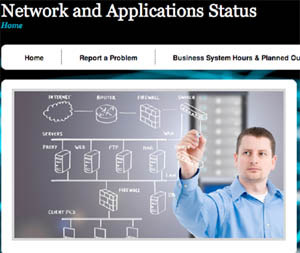Tech Problems?
Check the new network status site to see whats up.

You’re sitting at your computer, trying to use Blackboard or check your online library records. Or maybe you need to add a new event to your personal calendar, use WebPortal or perhaps look up a colleague in the SDSU Directory.
And darn it, it’s just not working! It might stall and leave you hanging, or maybe you can’t access the application at all.
You scratch your head, maybe swear a little under your breath and then you remember. There’s a newly launched site, just off the SDSU homepage, where you can go for answers! It’s: status.sdsu.edu. (Hint: bookmark this page!)
About the site
Spearheaded by Helen Habermann of University Computer Operations, the Network and Applications Status site is a “one-stop-shop” where staff, faculty and students can go for updates on what’s working and what’s not.
If you’re having a problem that has already been reported, you can find out details about when it’s expected to be resolved.
If you’re the first to experience the problem, you’ll find out how to report it to the appropriate office. (The site offers instructions for students and for faculty/staff.)
What systems does the new site track?
The site lists operation status for the following applications:
- AidLink
- Blackboard
- Calendar (Meeting Maker)
- Email for @mail.sdsu.edu, @sciences.sdsu.edu, @rohan.sdsu.edu
- Network
- San Diego Circuit
- SDSU Web Directory
- SIMS/R
- The PAC
- University Scholarship Management System
- WebPortal
- Websites, including library.sdsu.edu, www-rohan.sdsu.edu, www.sci.sdsu.edu, www.sdsu.edu
If you know of a campuswide application or system that should be listed and is not, please contact Helen Habermann, University Computer Operations, [email protected] or 619-594-3605.
Idea for the site
The idea for the site came originally from Kent McKelvey, director for Telecommunications and Network Services, and Skip Austin, TNS Network analyst, after they discovered similar sites at other universities.
“The new site will help us track the quality of the network, how much up or down time we have,” McKelvey said.
“It’s a repository of how good a job we’re doing. But its main value will be in providing solid information to the campus about what’s up and what’s not, and when.”
According to McKelvey, SDSU faculty and staff are understanding about occasional outages, as long as they know what’s going on.
“If there’s a problem and you don’t know what’s going on, that’s frustrating. If you can check the site and know ahead of time that something’s scheduled be out, then you can plan around it. Sharing information on the site will also cut down on phone calls to the help desk.”
Network and application problem solving
There will, of course, be times when a problem can’t be solved immediately, or the cause of an outage isn’t obvious.
“Even if we don’t know exactly what’s happening, we’ll put up a notice: ‘We’re currently experiencing a problem. It appears to be system X. We’ll update when we have more information.’ So then people will at least know it’s being worked on.”
McKelvey added that there’s also value in posting information about a system failure after the fact.
“Say that from 3–4 p.m. in this building, a switch failed. Equipment failures do happen,” he said. “People can check the site later and see that that’s why their system wasn’t functioning. So they’ll know what happened — it wasn’t a problem with their equipment.”
Building the site
UCO’s Habermann collaborated on the cross-divisional project with Diane Slagle in Student Affairs and Aaron Hoskins in University Relations and Development.
They built the site in the SDSU content management system that already delivers several university websites, including the homepage, the president’s office site and others. Content management systems simplify the process for creating and maintaining websites.
The system provides a platform that can be easily accessed by staff from on and off campus, a valuable asset to McKelvey and other staff monitoring the university’s network and system applications.
Users need only to receive log-in authorization and system training to make site updates. Detailed, easy-to-follow instructions have been provided to those who will be charged with making the updates.
McKelvey noted that IT staff are going to “need to train ourselves to go there immediately and put the information out” so that site information stays current and valuable.



